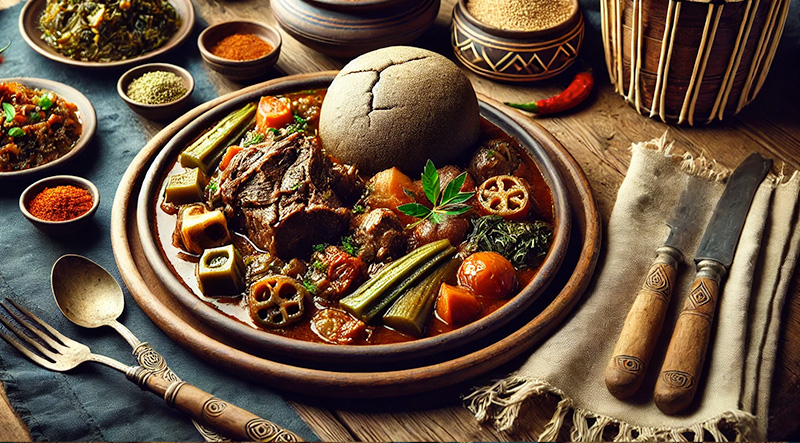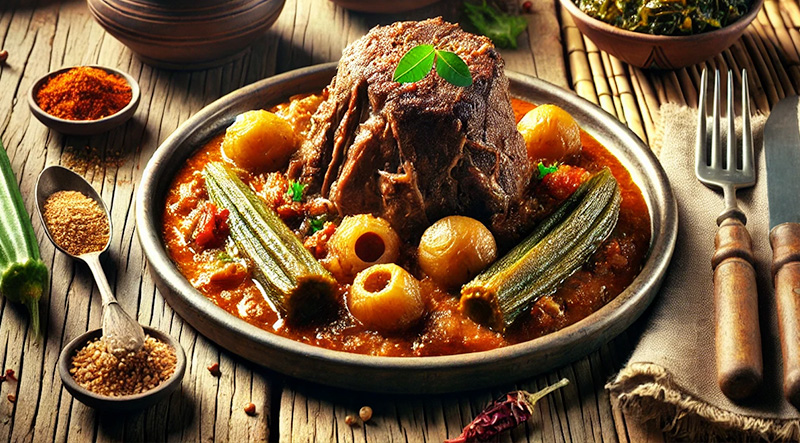Dive into the heart of Chadian cuisine with its national treasure, Jarret de Boeuf au Gombo with Boule. This is no ordinary stew; it's a rich, soul-warming celebration where succulent beef knuckle is slow-cooked to perfection, releasing its marrow and collagen until the meat is fall-apart tender. The stew is given its signature velvety body by gombo (okra), creating a luscious sauce that clings to every bite. But the magic truly happens when it's paired with its essential partner, Boule—a soft, steaming pillow of millet porridge, ready to be pinched off and used as the perfect edible scoop for every savory, spiced mouthful. Read More...
A Taste of the Sahel -The Hearty History of Chad’s National Dish:
In the heart of Central Africa, where the Sahara’s sands meet the grassy savannas of the Sahel, lies the nation of Chad. Its culture is a rich tapestry woven from the threads of over 200 ethnic groups, nomadic traditions, and a complex colonial history. To understand the soul of Chad, one need look no further than its shared table, and specifically, to the dish widely celebrated as its national treasure.
Deconstructing the Plate – Three Pillars of Chadian Life:
To understand the dish, we must first break it down into its three core components, each representing a vital aspect of Chadian history and geography.
Jarret de Boeuf (Beef Shank) – The Legacy of the Herder:
The use of beef, specifically the tough and flavorful shank cut (jarret de bœuf in French), points directly to Chad’s deep-rooted pastoralist culture. For centuries, cattle have been a measure of wealth and a cornerstone of the economy, particularly for groups like the Fulani and the Shuwa Arabs. The Chadian landscape, with its vast rangelands, is ideal for grazing.
The choice of shank is significant. It’s not a prime cut, but one that requires time, patience, and slow cooking to tenderize. This reflects a culinary tradition born of necessity and wisdom—making the most of every part of the animal. The long, slow simmering process breaks down the tough connective tissues, releasing immense flavor and creating a rich, unctuous broth that forms the soul of the stew. This method of slow cooking is a hallmark of Sahelian cuisine, perfected over generations around communal fires.
Gombo (Okra) – The African Foundation:
If the beef represents the pastoralist, the gombo, or okra, is the heart of the dish’s indigenous African identity. Okra is a vegetable with ancient roots in the continent, believed to have originated in the region of Ethiopia and Sudan before spreading across Africa and beyond.
In Chad, as in much of West and Central Africa, okra is cherished not just for its taste but for its unique thickening properties. When cooked, it releases a mucilage that gives the stew its characteristic viscous, slightly “slimy” texture, known in Francophone Africa as sauce gluante. This texture is highly prized, as it helps the sauce cling perfectly to the staple accompaniment. Okra is the authentic, pre-colonial anchor of the dish, a taste of the land itself.
Boule- The Grain of the Sahel:
The final component, boule (French for “ball”), is the essential starchy staple that makes the meal complete. Boule is a thick, stiff porridge, traditionally made from the grains that thrive in Chad’s arid climate: millet or sorghum. These hardy cereals have been cultivated in the Sahel for millennia, providing the caloric backbone for its civilizations.
The preparation of boule is a ritual in itself, involving pounding the grain into flour and cooking it with water until it forms a dense, moldable dough. It is served as a large, communal ball from which diners tear off small pieces with their right hand. They then use these pieces as an edible utensil, dipping them into the rich beef and okra stew. The boule is not just food; it is the plate, the spoon, and the symbol of shared sustenance.
The French Connection – A Name, Not an Origin:
One might wonder about the distinctly French name, “Jarret de Boeuf au Gombo.” This points to the final layer of the dish’s history: French colonization. From the early 20th century until its independence in 1960, Chad was part of French Equatorial Africa.
The French did not invent this dish. Chadians were already slow-cooking tough cuts of meat with local vegetables like okra and serving it with millet porridge long before the colonialists arrived. However, French became the language of administration, education, and formal dining. Local dishes were often given French names to be presented in restaurants or official settings.
Thus, “Jarret de Boeuf au Gombo” is a linguistic marriage: the adoption of French culinary terms to describe a fundamentally Chadian creation. It represents a post-colonial identity that acknowledges historical influence without surrendering its authentic roots.
A Symbol of Unity and Hospitality:
Today, Jarret de Boeuf au Gombo with Boule is more than just the unofficial national dish. It is a symbol of Chadian hospitality. To be invited to share it is a profound gesture of welcome. Eaten from a common bowl, it dissolves social barriers and reinforces community bonds.
While the classic recipe forms the standard, variations abound. In the south, you might find it spicier with a healthy dose of piment. Near Lake Chad, fish might replace the beef. Other vegetables like tomatoes, eggplant, or peanuts can be added for complexity. But the core trio—slow-cooked meat, okra, and a grain-based boule—remains the unwavering constant.
To eat Jarret de Boeuf au Gombo is to partake in a living history. It is to taste the pastoral wealth of the savanna, the ancient agricultural wisdom of the Sahel, and the complex cultural dialogue that has shaped a nation. It is, in every satisfying bite, the hearty, resilient, and welcoming spirit of Chad.
Making the Jarret de Boeuf au Gombo (The Stew)


Serving:
Enjoy this incredible taste of Chad
The total time required to prepare and cook Jarret de Boeuf au Gombo with Boule is approximately 4 hours. This time is divided into about 1 hour of active preparation and 3 hours of cooking. The active prep includes chopping the vegetables, searing the beef to build a flavorful crust, and the hands-on, vigorous stirring needed to make the Boule. The majority of the time, however, is dedicated to the slow, gentle simmering of the beef stew, a crucial and mostly hands-off period that allows the tough beef shank to become perfectly tender and for the rich, complex flavors of the dish to meld together beautifully.
Based on the provided recipe, a single serving of Jarret de Boeuf au Gombo with Boule is a hearty and energy-dense meal, with an estimated calorie count ranging from approximately 650 to 850 calories. This is a nutritional estimate, as the final count can vary based on the specific fat content of the beef shank and the exact serving size. The majority of the calories are derived from the protein and fat in the slow-cooked beef shank and the dense carbohydrates from the millet flour used to prepare the Boule. The vegetables, particularly the low-calorie okra, contribute essential vitamins and fiber, making this a well-rounded and deeply satisfying dish designed to provide lasting energy.







